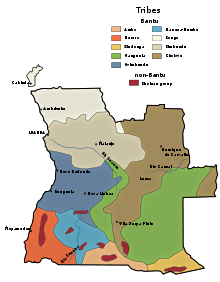| Bailundo revolt of 1902 | |||||||
|---|---|---|---|---|---|---|---|
 Ovimbundu area within modern day Angola | |||||||
| |||||||
| Belligerents | |||||||
|
|
Kisanji Luimbi[1] | ||||||
| Commanders and leaders | |||||||
|
|
Kalandula (POW) Mutu ya Kevela † Samakaka Livongue † Civava †[1] | ||||||
| Strength | |||||||
|
750 troops 1,000 Auxiliaries[1] | 10,000[1] | ||||||
| Casualties and losses | |||||||
| Minimal[1] | +2,000 casualties[1] | ||||||
| +120 civilians[1] | |||||||
| History of Angola | ||||||||||||||||
|---|---|---|---|---|---|---|---|---|---|---|---|---|---|---|---|---|
 | ||||||||||||||||
|
||||||||||||||||
| Post-war Angola’s | ||||||||||||||||
| See also | ||||||||||||||||
| Years in Angola | ||||||||||||||||
The Bailundo revolt was an insurrection launched by the Ovimbundu kingdom of Bailundo and its allies against the Portuguese Empire. The revolt was prompted by the sudden decline of the price of root rubber, pitting the indigenous population against European immigrants and aboriginal loyalists. The revolt lasted between 1902 and 1904, ending in a Portuguese victory.